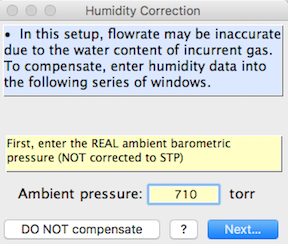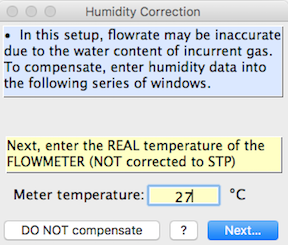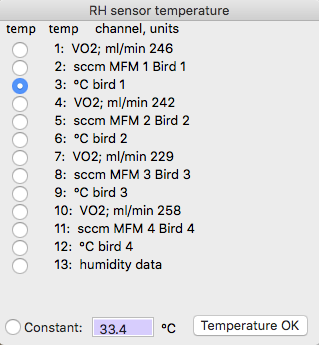
 |
Gas exchange: water vapor compensation
|
|
As can be seen in this diagram, the importance of water vapor compensation is greatest at high ambient temperatures and high humidities. For example, at a temperature of 30 °C, saturated air (100% R.H.) is about 4 percent water vapor by volume. That proportion increases to about 7 percent at 40 °C. You should also keep in mind that these values are for a total barometric pressure of 1 atmosphere. Since saturation vapor pressure at a given temperature is constant regardless of the total pressure in the system, the fractional water vapor content increases as total pressure decreases. For example, if you are working at an altitude of 2000 meters (where atmospheric pressure is roughly 590 torr), saturated air at 30 °C contains about 5.4% water vapor by volume. You can reduce or avoid these errors by using estimates of humidity, or preferably measurements of humidity or dew point, to calculate the volumetric fraction of incurrent gas comprised of water. This figure should give you some idea of the need to compensate, given the temperature and pressure conditions you work with. Note that the temperature and pressures of importance are those at the position of the flowmeter, and not elsewhere in your system. Clearly, if you are working at fairly low humidities and the temperature of your flowmeter is about 20 °C or lower, the expected error is on the order of 1% or less, and probably can be safely ignored. Even in fairly warm conditions (around 30 °C), you can reduce the expected error to about 2% if you can guess relative humidity within 50%.
Note that it's usually necessary to adjust to ambient barometric pressure and temperature (even if flow rate has already been set to STP). This is because the partial pressure of water vapor is constant at a given combination of relative humidity and temperature, regardless of the partial pressure of the rest of the gas mixture. Therefore a given RH or vapor pressure will represent a different fraction of total gas volume at STP than under ambient pressure and temperature. You also have the option of not compensating, if you wish.  
You are next asked for a channel containing humidity (or water vapor) data; alternately you can use a constant RH (the default is 20%). This is shown below, at left. Next you are next asked whether the humidity data are in units of relative humidity or dew point temperature, or (if using vapor pressure), units of kiloPascals or micrograms/mL (below, at right):
|
 If the data are in
units of relative humidity, you are asked to select a channel containing
humidity temperature data (as shown at right), or a constant temperature
for the RH sensor: If the data are in
units of relative humidity, you are asked to select a channel containing
humidity temperature data (as shown at right), or a constant temperature
for the RH sensor:
The software will compensate for temperature differences between the humidity sensor and the flowmeter.
|
| Other links: |